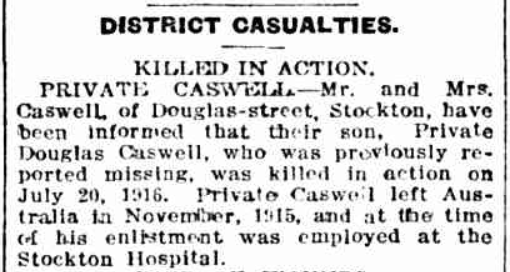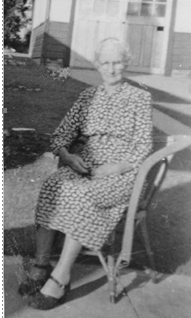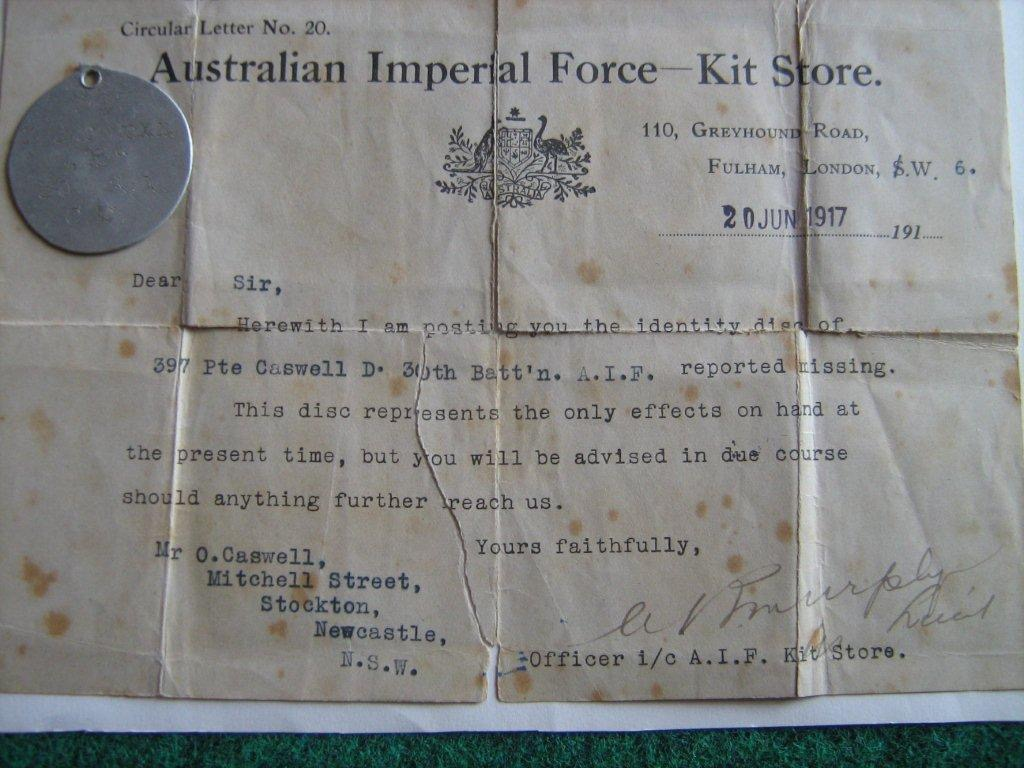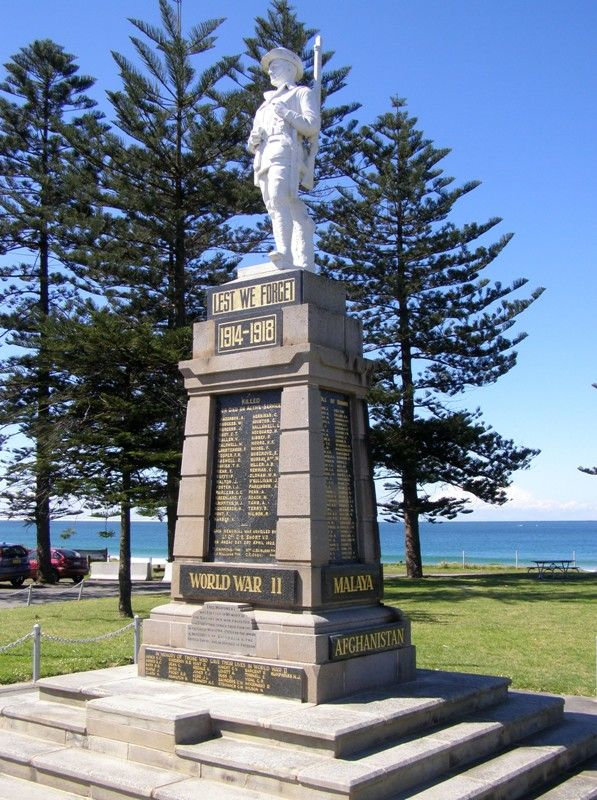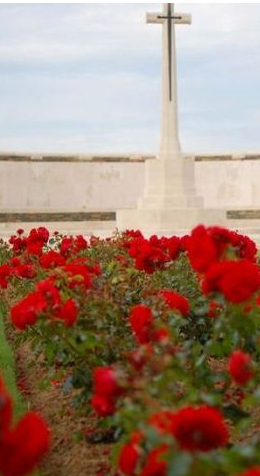
Douglas CASWELL
Eyes hazel, Hair fair, Complexion ruddy
From Powick, Worcester to Stockton NSW
Y DNA is being sought to help identify Douglas:
We have not found a living male named Caswell from the soldier’s paternal ancestors’ line, a line which we believe originated in Worcester and Birmingham in England. We would appreciate any information whatsoever, especially from any Caswell family members who have origins in that part of the UK. There was another Caswell family living in Powick in the 19th century and we would also love to hear from them.
Please see contact details located in the panel at the end of this story.
The Caswell family emigrated from Powick, Worcestershire where Douglas’s father, Edwin Ebborn Caswell, worked in the coal industry. His mother, Sophie Mary Caroline nee Beckel, was a lady’s maid and dressmaker who had been born in Germany. Their son Douglas was born on 28 July 1894, soon to be followed by two daughters and a second son.
Leaving the family back in England, Douglas, 17, and his father arrived in Sydney on 23 April 1912 travelling 3rd class on the ship SS Zealandic which was ultimately bound for New Zealand. The two Caswell men found their way to Newcastle in New South Wales and settled in the suburb of Stockton.
This was a “boom” time in Newcastle and jobs were plentiful. Both Douglas and his father found work at the Stockton Mental Hospital and were soon able to financially provide for the immigration of Sophie and the three younger children. They left England on 14 August 1913 on Demosthenes arriving as unassisted immigrants in Sydney on 28 September 1913. They were noted on the passenger register as: Sophie Caswell 44, Miss Nellie Caswell 17, Miss Margaret Caswell 15, and Master Ebborn Caswell 11.
Sadly, we have not located a photo of Douglas but have obtained photographs of his sister, Nellie, and brother, Ebborn (known as Joe).
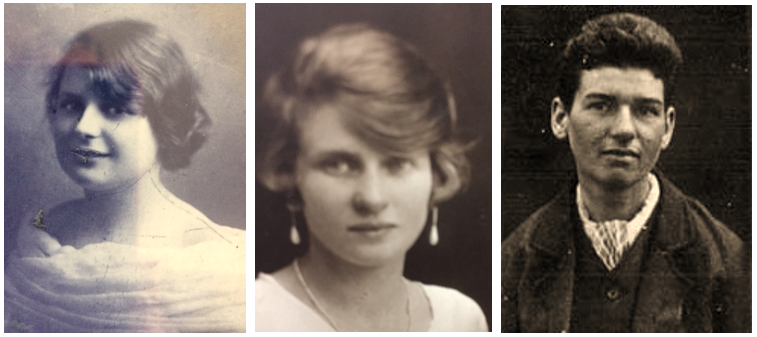
Enlisting and farewelling hometown Newcastle
In his July 1915 attestation papers, Douglas recorded his parents as Eberon (Ebborn) and Sophie Caswell, residing at Douglas St, North Stockton. He was 21 years old and had been employed as a butcher prior to enlisting.
While Douglas joined up in Liverpool, it is probable he was recruited in Newcastle with fellow locals, Arthur and Clarence Taylor. The three Newcastle lads were given a formal farewell and a gift from the Mayor whilst on their final leave – a fountain pen, in Douglas’ case. It appears that the three young soldiers were reluctant attendees with the Mayor pointing out:
that the boys had only agreed to be present upon the understanding that they would not be kept long, as their parents were awaiting them at home
For their farewell leave, there would have been parents, siblings and perhaps sweethearts, friends and neighbours, former workmates, and other young men from Stockton. Perhaps a family feast was included, with family baking food to take back to camp - a very special time for all. The family would have been left with that image of their optimistic young soldier, comfortable with his new world, new mates and, if anyone had any fears, they probably did not express them. Indeed, for parents and families this was possibly the last time they would see their son, and it would have been agonizing, no matter how strong their patriotism.
Local communities were very supportive of the soldiers and Stockton as a small town would have had a good turnout. In fact, history would eventually show that Stockton boys who died in the war numbered 32 while 52 soldiers from the broader Hunter region were eventually listed as missing after the Battle of Fromelles and commemorated at the VC Corner Cemetery.
Source David Dial: Where Heroes Sleep (2002) . Douglas Caswell was amongst those numbers.
Training, marching to the ship - chocolates and cigarettes
In the Liverpool training camp, Douglas together with Arthur and Clarence Taylor were allocated to the newly formed 30th Battalion, a part of the 8th Brigade. Most of its recruits hailed from the Newcastle region and other parts of country New South Wales. Douglas and Clarence were allocated to B company while Arthur was in C company. Arthur was later transferred to a field artillery unit as a gunner.
Having survived the camp, the 30th Battalion were well trained, disciplined, able to effectively use their rifle and bayonet, run with packs or heavy ammunition boxes and, by the beginning of November 1915, they were ready to go overseas. Some country boys had never seen big ships or aeroplanes before, so it was the start of an enormous adventure.
Excitement was building as the time to leave arrived. There was the troop train to Central, marching to a review in the Domain, perhaps staying at the Sydney Showgrounds overnight, and then on to the troopship Beltana the next day. While marching to the ship, the crowd showered them with chocolates and cigarettes and photos of the time show massed crowds dominated by Union Jack flags.
With a huge gathering on the wharf to call and sing the farewell songs, ribbons became entangled, streamers tugging, and military bands playing. Launches always followed the troopships down to the harbour and out through the heads with packed ferries joining them, ships horns sounding, and the deep horn of the Beltana responding and reminding the small ships to stay clear.
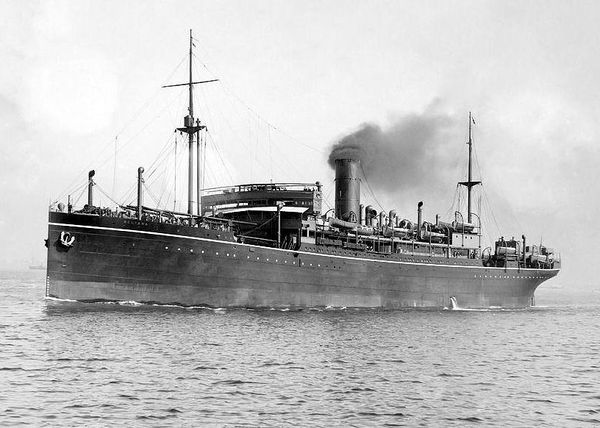
After finally departing Australian shores, the more serious military restrictions began such as censorship of mail. Many men, not wanting to have their letters read by others, said very little. After a while however, it became routine and initial reticence was overcome and the writers expressed themselves freely. Their pay rates immediately dropped from six shillings to one or two shillings a day, depending on what was allocated to families.

The ship headed north through the Indian Ocean to Colombo. It didn’t take the Diggers long to begin organising rickshaw races and betting on them in all the heat and tropical environment, urging the rickshaw drivers to greater efforts.
Egypt and then France
The troops arrived in Egypt about 28 days after leaving Sydney, first at Port Taufiq in the town of Suez, then entrained again north into the Arabian Peninsula to Tel-el-Kebir, east of Cairo. Disease was common and both Clarence Taylor and Douglas were put into hospital quarantine for nearly a fortnight during March 1916 having been in contact with diphtheria.
In June 1916, the 30th Battalion proceeded to France, destined for the Western Front. Their first major battle was at Fromelles on 19 July 1916. It was tasked with providing carrying parties for supplies and ammunition but was soon drawn into the vicious fighting.
On 20 July 1916, Private Douglas Caswell was reported missing. His fellow Stockton recruit, Private Clarence Taylor was severely wounded and evacuated to England for treatment.
Missing in action
In mid-August, Douglas’ family were advised that that Douglas was missing in action.
On 28 August, Private 792 Arthur C. WALKER gave evidence to the Red Cross that he had seen Douglas wounded and believed that he had been killed. Walker, also with the 30th Battalion, had been wounded at Fromelles and later in the war was awarded the military medal. He stated:
“I knew Caswell; his initial was D. He was in the original Bn. and he was in B.V. No. 1 Section. I saw him lying wounded in No Man's Land on 19.7.16 at Fleurbaix, between 8 and 9 p.m. This was in the 4th. wave and he and I were carrying ammunition. He was hit in the hip and leg and could not get up but rolled into a shell hole and had to be left. 2 of my mates and I went back to where we left him and although I am perfectly sure that we found the place where we had left him the shell hole was then filled in. I feel quite sure that he must have been killed and buried and not taken prisoner.”
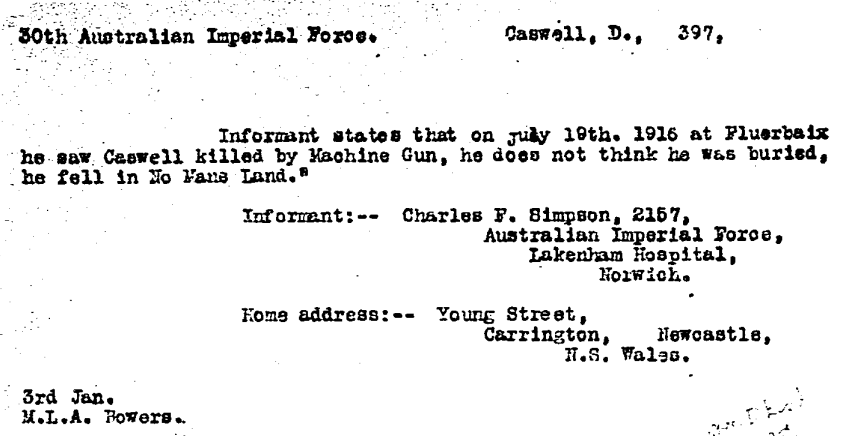
Generally, the Red Cross passed information received from fellow soldiers to the families of the missing so it is likely that the Caswell family were aware of Douglas’ likely fate before any official confirmation was received.
In October 1916, Douglas’ identity disc was returned by the Germans through the Red Cross and his name was included on the German death list dated 4 November 1916.
By April 1917, authorities had officially confirmed Douglas’ death and notified his family accordingly. His identity disc was returned to the family in late 1917.
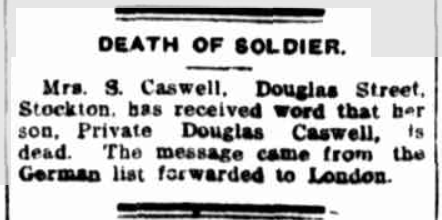
Remembered over the years
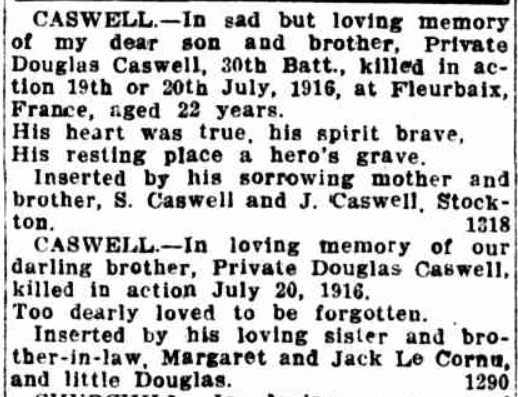
One grandson remembered Sophie as a small white-haired lady who sat quietly, often in her room. He once asked about this, and his mother told him that Sophie never got over losing her much loved son, Douglas, in the war.
Douglas’s identity disc and its documentation has been passed down the generations over the decades. In 2014 family member, Deb Carrigan, liaised with the Australian War Memorial to allow the ID tag to be exhibited at the Fromelles Museum Pheasant Wood Cemetery for the following 10 years (and perhaps longer. ) Another of the Caswell descendants was at the 2016 centenary commemoration at Fromelles to honour Douglas’ service.
Douglas is also commemorated on his parents’ headstone in the Stockton cemetery as well as on:
- Panel 2 of V.C. Corner Australian Memorial and Cemetery, Fromelles, France
- Panel 116 of Australian War Memorial, Canberra, ACT
- Stockton War Memorial, Stockton, NSW
- St Paul’s Church Honour Roll, Stockton, NSW

The Present - The search for Douglas via a Y DNA donor.
Mitochondrial DNA donors have been located and have donated DNA, and whilst this is an important step, a Y DNA donor is greatly needed. A Y DNA donor will most likely be a male named Caswell.
The Caswell family have also been searching for a Caswell connection since the mass grave was found, having taken many steps in their research including travel to England. Deb Carrigan travelled to the UK, as did a cousin, and while in Worcester, Deb was intervewed by local newspaper journalist, Richard Vernalls, who took an interest in the search and wrote more than one article, hoping to find a suitable donor. He drove Deb around the Powick area, including where the Salt Pits farm and the coal yard were originally located. In spite of this publicity and other research, Deb and her cousins were unable to find any Caswells.
The following is an extract of the article, printed in the Worcester News, 18 May 2009.
“One of Worcestershire’s sons served as a soldier in one of the bloodiest battles of the First World War, it has been revealed.
Douglas Caswell, who was born in Powick, near Worcester, is one of up to 400 servicemen believed to rest in a burial pit dug behind German lines following the Battle of Fromelles in 1916. The pits in northern France were dug by German soldiers.
…..He had emigrated with his father Edwin Caswell, a coal agent, in 1912, while his mother Sophie brought the remaining children, Nellie, Margaret and Ebborn, to Australia in 1913. The family were recorded as living in Sand Pits, Powick, in 1901.
Bob Jenkins, of Upton Road, Powick, said locals remembered the coal yard but he had been unable to find anybody who could recall the Caswells.”
[[Source: Richard Vernalls, Worcester News, 18 May 2009 Remains of county soldier believed to be in mass grave ]]
Follow up work by researchers in phoning some of Deb’s contacts in the UK and writing again to the Worcester News in England has yielded no fresh information.
It seems that this branch of the Caswell family had moved to Nottingham. The only male in the next generation died in World War 2 (Airforce) some months before his only child, Michael, was born. Eventually, we found Michael and he was delighted to give a DNA sample, not long before he passed away. Two descendants of Douglas’ sisters had previously donated DNA but it is important to find another Y DNA donor. In this search, we are looking at any Caswell families from Worcester or Birmingham, who may share ancestors with Douglas.
The Fromelles Association (contact royce@fromelles.info or geoff@fromelles.info) are currently seeking family of this soldier, with a view to the identification of suitable DNA donors for the sole, specific purpose of identification. We welcome all contact in this regard.
DNA NEEDED - Searching for CASWELL DNA – a wider search
| Soldier | Douglas CASWELL - KIA 1916, Fromelles, France |
| Parents | Edwin Ebborn CASWELL from Powick, Worcester 1868 -1919 and Sophie Caroline Mary BECKEL from Weisbaden, Germany 1866-1953 |
| Grandparents | |||
| Paternal | James CASWELL 1821-1873 Worcestershire and Louisa Kezia EBBORN 1831-1922 Worcestershire. |
Earlier Caswell generations
Samuel CASWELL 1787 – 1874, a carpenter of Powick, Worcester. We believe this man’s father - possibly also Samuel Caswell - came from Birmingham.
There is another family who were in Powick in the 1800s and had sons named Edwin - but we can’t find a connection.
Summary: In searching for Y DNA for Douglas, we are looking at any Caswell families from Worcester or Birmingham, who may share ancestors with Douglas.
Seeking DNA Donors

Contacts
(Contact: carla@fromelles.info or geoffrey@fromelles.info).
(Contact: army.uwc@defence.gov.au or phone 1800 019 090).
Donations
If you are able, please contribute to the upkeep of this resource.
(Contact: bill@fromelles.info ).



